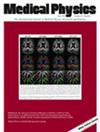Rapid in vivo EPID image prediction using a combination of analytically calculated attenuation and AI predicted scatter
Abstract
Background
The electronic portal imaging device (EPID) can be used in vivo, to detect on-treatment errors by evaluating radiation exiting a patient. To detect deviations from the planning intent, image predictions need to be modeled based on the patient's anatomy and plan information. To date in vivo transit images have been predicted using Monte Carlo (MC) algorithms. A deep learning approach can make predictions faster than MC and only requires patient information for training.
Purpose
To test the feasibility and reliability of creating a deep-learning model with patient data for predicting in vivo EPID images for IMRT treatments.
Methods
In our approach, the in vivo EPID image was separated into contributions from primary and scattered photons. A primary photon attenuation function was determined by measuring attenuation factors for various thicknesses of solid water. The scatter component of in vivo EPID images was estimated using a convolutional neural network (CNN). The CNN input was a 3-channel image comprised of the non-transit EPID image and ray tracing projections through a pretreatment CBCT. The predicted scatter component was added to the primary attenuation component to give the full predicted in vivo EPID image. We acquired 193 IMRT fields/images from 93 patients treated on the Varian Halcyon. Model training:validation:test dataset ratios were 133:20:40 images. Additional patient plans were delivered to anthropomorphic phantoms, yielding 75 images for further validation. We assessed model accuracy by comparing model-calculated and measured in vivo images with a gamma comparison.
Results
Comparing the model-calculated and measured in vivo images gives a mean gamma pass rate for the training:validation:test datasets of 95.4%:94.1%:92.9% for 3%/3 mm and 98.4%:98.4%:96.8% for 5%/3 mm. For images delivered to phantom data sets the average gamma pass rate was 96.4% (3%/3 mm criteria). In all data sets, the lower passing rates of some images were due to CBCT artifacts and patient motion that occurred between the time of CBCT and treatment.
Conclusions
The developed deep-learning-based model can generate in vivo EPID images with a mean gamma pass rate greater than 92% (3%/3 mm criteria). This approach provides an alternative to MC prediction algorithms. Image predictions can be made in 30 ms on a standard GPU. In future work, image predictions from this model can be used to detect in vivo treatment errors and on-treatment changes in patient anatomy, providing an additional layer of patient-specific quality assurance.

 求助内容:
求助内容: 应助结果提醒方式:
应助结果提醒方式:


